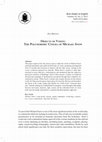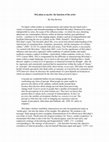Papers by Dan Browne
San Francisco Cinematheque, 2017
A short survey of the lyrical poetic films of Paul Clipson (1965–2018), commissioned in 2017 by S... more A short survey of the lyrical poetic films of Paul Clipson (1965–2018), commissioned in 2017 by Steve Polta of San Francisco Cinematheque, on the occasion of a new commission, "BLACK FIELD," by Clipson and Zachary Watkins.
Hors Champ, 2018
Reflections on the passing of filmmaker Paul Clipson.
An interview with American film and video artist Mary Helena Clark, published via Incite Journal ... more An interview with American film and video artist Mary Helena Clark, published via Incite Journal of Experimental Media.
Notes and reflections on the filmography of Stephen Broomer, included in "The Transformable Momen... more Notes and reflections on the filmography of Stephen Broomer, included in "The Transformable Moment: The Films of Stephen Broomer," eds. Tom McSorley and Scott Birdwise (Canadian Film Institute, 2014)

This paper explores how the sensory spaces within the works of Michael Snow represent kinesthetic... more This paper explores how the sensory spaces within the works of Michael Snow represent kinesthetic and audile-tactile modes of vision, proposing an integrated form of visuality that functions in tandem with the other senses, relating to the sensus communis proposed by Aristotle. While Snow’s cinema is often characterized as more objective, technological, and immaterial than the subjective and poetic aesthetic of Brakhage, Snow’s films present a similar yet distinctly idiosyncratic paradigm of multisensory perception through their sculptural, deconstructive nature. While Snow’s camera lens remains focused on the exterior world, his films present spaces that journey far from the illusory and disembodied nature of the scopic regime that Martin Jay (1988) terms “Cartesian dualism,” instead seeking out a unified field of energetic vision through relationships between movement, duration, sight, sound, and the embodied limits of vision itself, and are deeply informed by a sustained multidisciplinary approach.
Conference Presentations by Dan Browne

For McLuhan, the artist is the individual able to live fully in the present, “the person who inve... more For McLuhan, the artist is the individual able to live fully in the present, “the person who invents the means to bridge between biological inheritance and the environments created by technological innovation.” (1988: 98) This role corresponds to that of media ecologist, a position in which McLuhan clearly situated himself. Identifying McLuhan as a mystic may initially seem a peculiar gambit, yet it places him within a lineage to which he maintained allegiance: Joyce, Pound, Eliot, Lewis, and Aquinas. His entire theory of media as bodily extension bespeaks an underlying sense of unity, a tendency supported by his implicit religious faith. The mysteries of multiplicity and unity permeate McLuhan's understanding of communication as simultaneous participation and transformation, and it is from this boundless source that the richness of his thought derives. G.K. Chesterton defined mystics as those who do not hide mysteries, but instead reveal them. Through this definition, we may understand mysticism not as an esoteric concept that defies categorization, but a practical approach for dealing with the ultimate and irreducible wonder that confronts our being in the world.
No other figure in communications and cultural studies provokes such a variety of responses as Marshall McLuhan. Dismissed by many, indispensable to some, the scope of his influence today—in which his aphorisms are commonplace rhetoric within an Internet-fuelled, post-globalized society—continues in its wide-ranging impact. However, the significance of McLuhan’s innovative approach remains a subject of continued debate and misunderstanding. In this paper I propose McLuhan is best interpreted as an artist-mystic, and that his study of the arts combined with his Canadian heritage performs a central role in the formation of his insights—most characteristically within his model of acoustic space.
For McLuhan, the artist is the individual able to live fully in the present, acting as a distant early warning system in registering the blows of media: “the person who invents the means to bridge between biological inheritance and the environments created by technological innovation.” (1988: 98) The role of the artist is thus equated with that of media ecologist—a position in which McLuhan clearly situated himself. His entire theory of media as bodily extension bespeaks an underlying sense of unity; a tendency supported by his religious faith, though rarely posed overtly in his writings. Identifying McLuhan as a mystic may seem a peculiar gambit, yet nonetheless places him within a proper context of the lineage to which he maintained allegiance: Joyce, Pound, Eliot, Lewis, Aquinas. In his first article, McLuhan quotes G.K. Chesterton: “Real mystics don’t hide mysteries, they reveal them.” Through this definition, we may understand mysticism not as an esoteric concept defying categorization, but as a practical approach for dealing with the ultimate and irreducible mystery and wonder that confronts our being in the world. The mystery of multiplicity and unity permeates McLuhan’s understanding of communication as participation and transformation, and it was this that led him to oppose the Shannon-Weaver transmission model of communication predominant at his time of writing.
Talks by Dan Browne
Interview between Edwin Rostron and Dan Browne for Edge of Frame.
Drafts by Dan Browne
Unpublished, 2018
Reflections on a trilogy of films by Madi Piller
Film Studies Journals by Dan Browne

Found Footage Magazine , 2019
Found Footage Magazine is an independent and printed film journal distributed worldwide. It offer... more Found Footage Magazine is an independent and printed film journal distributed worldwide. It offers theoretical, analytical and informative content that hinges on the use of archival images in media production practices. FFM fills the void created by the fact that there has not been, up to this time, any forum for the collection and dissemination of information, critical thinking, and discussion of found footage cinema including all its manifestations: recycled cinema, essay film, collage film, compilation film, archival cinema, mash-up…
FFM accommodates a selection of articles and sections aimed at exploring issues of ethics, politics, form and content related to the culture of recycled cinema: monographs, interdisciplinary essays, interviews and opinion pieces concerning the eclectic universe of found footage filmmaking.
Collaborators Issue #5: Carlos Adriano, Peggy Ahwesh, Zachariah Anderson, Alejandro Bachmann, Matthieu Bourel, Louise Bourque, Dan Browne, María Cañas, Eli Craven, Alexei Dmitriev, Éric Falardeau, Mariana Freijomil, Peter Gidal, Douglas Gordon, André Habib, Kamila Kuc, Matthew Levine, Péter Lichter, Johann Lurf, Scott MacDonald, Guy Maddin, Yves-Marie Mahé, Bori Máté, Alice Michaud-Lapointe, Louis Pelletier, Jonathan Rosenbaum, Mimmo Rotella (SIAE), John Stezaker, César Ustarroz, and Annaëlle Winand.
Special Issue #5 contains a dossier on 'Dirty Movies & Second Hands Poetics" (coordinated by André Habib).











Uploads
Papers by Dan Browne
Conference Presentations by Dan Browne
No other figure in communications and cultural studies provokes such a variety of responses as Marshall McLuhan. Dismissed by many, indispensable to some, the scope of his influence today—in which his aphorisms are commonplace rhetoric within an Internet-fuelled, post-globalized society—continues in its wide-ranging impact. However, the significance of McLuhan’s innovative approach remains a subject of continued debate and misunderstanding. In this paper I propose McLuhan is best interpreted as an artist-mystic, and that his study of the arts combined with his Canadian heritage performs a central role in the formation of his insights—most characteristically within his model of acoustic space.
For McLuhan, the artist is the individual able to live fully in the present, acting as a distant early warning system in registering the blows of media: “the person who invents the means to bridge between biological inheritance and the environments created by technological innovation.” (1988: 98) The role of the artist is thus equated with that of media ecologist—a position in which McLuhan clearly situated himself. His entire theory of media as bodily extension bespeaks an underlying sense of unity; a tendency supported by his religious faith, though rarely posed overtly in his writings. Identifying McLuhan as a mystic may seem a peculiar gambit, yet nonetheless places him within a proper context of the lineage to which he maintained allegiance: Joyce, Pound, Eliot, Lewis, Aquinas. In his first article, McLuhan quotes G.K. Chesterton: “Real mystics don’t hide mysteries, they reveal them.” Through this definition, we may understand mysticism not as an esoteric concept defying categorization, but as a practical approach for dealing with the ultimate and irreducible mystery and wonder that confronts our being in the world. The mystery of multiplicity and unity permeates McLuhan’s understanding of communication as participation and transformation, and it was this that led him to oppose the Shannon-Weaver transmission model of communication predominant at his time of writing.
Talks by Dan Browne
Drafts by Dan Browne
Film Studies Journals by Dan Browne
FFM accommodates a selection of articles and sections aimed at exploring issues of ethics, politics, form and content related to the culture of recycled cinema: monographs, interdisciplinary essays, interviews and opinion pieces concerning the eclectic universe of found footage filmmaking.
Collaborators Issue #5: Carlos Adriano, Peggy Ahwesh, Zachariah Anderson, Alejandro Bachmann, Matthieu Bourel, Louise Bourque, Dan Browne, María Cañas, Eli Craven, Alexei Dmitriev, Éric Falardeau, Mariana Freijomil, Peter Gidal, Douglas Gordon, André Habib, Kamila Kuc, Matthew Levine, Péter Lichter, Johann Lurf, Scott MacDonald, Guy Maddin, Yves-Marie Mahé, Bori Máté, Alice Michaud-Lapointe, Louis Pelletier, Jonathan Rosenbaum, Mimmo Rotella (SIAE), John Stezaker, César Ustarroz, and Annaëlle Winand.
Special Issue #5 contains a dossier on 'Dirty Movies & Second Hands Poetics" (coordinated by André Habib).
No other figure in communications and cultural studies provokes such a variety of responses as Marshall McLuhan. Dismissed by many, indispensable to some, the scope of his influence today—in which his aphorisms are commonplace rhetoric within an Internet-fuelled, post-globalized society—continues in its wide-ranging impact. However, the significance of McLuhan’s innovative approach remains a subject of continued debate and misunderstanding. In this paper I propose McLuhan is best interpreted as an artist-mystic, and that his study of the arts combined with his Canadian heritage performs a central role in the formation of his insights—most characteristically within his model of acoustic space.
For McLuhan, the artist is the individual able to live fully in the present, acting as a distant early warning system in registering the blows of media: “the person who invents the means to bridge between biological inheritance and the environments created by technological innovation.” (1988: 98) The role of the artist is thus equated with that of media ecologist—a position in which McLuhan clearly situated himself. His entire theory of media as bodily extension bespeaks an underlying sense of unity; a tendency supported by his religious faith, though rarely posed overtly in his writings. Identifying McLuhan as a mystic may seem a peculiar gambit, yet nonetheless places him within a proper context of the lineage to which he maintained allegiance: Joyce, Pound, Eliot, Lewis, Aquinas. In his first article, McLuhan quotes G.K. Chesterton: “Real mystics don’t hide mysteries, they reveal them.” Through this definition, we may understand mysticism not as an esoteric concept defying categorization, but as a practical approach for dealing with the ultimate and irreducible mystery and wonder that confronts our being in the world. The mystery of multiplicity and unity permeates McLuhan’s understanding of communication as participation and transformation, and it was this that led him to oppose the Shannon-Weaver transmission model of communication predominant at his time of writing.
FFM accommodates a selection of articles and sections aimed at exploring issues of ethics, politics, form and content related to the culture of recycled cinema: monographs, interdisciplinary essays, interviews and opinion pieces concerning the eclectic universe of found footage filmmaking.
Collaborators Issue #5: Carlos Adriano, Peggy Ahwesh, Zachariah Anderson, Alejandro Bachmann, Matthieu Bourel, Louise Bourque, Dan Browne, María Cañas, Eli Craven, Alexei Dmitriev, Éric Falardeau, Mariana Freijomil, Peter Gidal, Douglas Gordon, André Habib, Kamila Kuc, Matthew Levine, Péter Lichter, Johann Lurf, Scott MacDonald, Guy Maddin, Yves-Marie Mahé, Bori Máté, Alice Michaud-Lapointe, Louis Pelletier, Jonathan Rosenbaum, Mimmo Rotella (SIAE), John Stezaker, César Ustarroz, and Annaëlle Winand.
Special Issue #5 contains a dossier on 'Dirty Movies & Second Hands Poetics" (coordinated by André Habib).